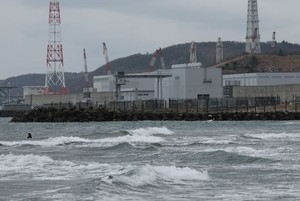By AKIHIRO TANAKA/ Staff Writer
October 18, 2023 at 15:00 JST
Julie Stephan arrived at Kansai International Airport a day before her flight in August, when Typhoon No. 7 hit the Kinki region in western Japan.
The French translator was prepared for the worst from the storm. And thankfully for her and hundreds of others like her, so was the airport.
Kansai Airports, operator of the airport, revised its business continuity plan for natural disasters and strengthened shore protection and facilities to prevent a repeat of the catastrophe that developed in September 2018 during Typhoon No. 21.
Up to 8,000 people were trapped inside the off-shore inundated airport after a tanker ship crashed into a connection bridge.
“We will never forget what we learned from Typhoon No. 21,” said Yoshiyuki Yamaya, CEO of Kansai Airports. “Being always prepared is extremely important.”
RELIEF SUPPLIES
After touring the Kansai region and Tokyo, Stephan, 38, and her family arrived at Kansai Airport on the night of Aug. 14, looking to leave Japan on Aug. 15.
They arrived a day early because of the risk of the connection bridge being closed by Typhoon No. 7.
Around 650 people stayed overnight at the airport that day.
Kansai Airport had ample relief supplies on hand, such as food, drinkable water and baby goods.
Sleeping bags, batteries and foodstuffs prepared especially for Muslims were newly added to the supply list. The airport also increased its estimated number of stranded passengers in disasters from 8,000 to 12,000.
Stephan received bedrolls and water for her family from airport staff.
“I was nervous because we were here with our child,” she said. “We did not bring something to cover our bodies, so the sleeping bags were helpful. I appreciate Japanese-style hospitality.”
A burger restaurant, a convenience store and other shops were kept open for the passengers.
Under Kansai Airport’s business continuity plan amended four years earlier, the normal airport environment should continue for 24 hours after the onset of a disaster.
The revised plan specifies 18 categories in which airport functions could be lost in a disaster and provides countermeasures and recovery processes.
During Typhoon No. 7, information display panels in four languages continued showing reports on the weather, traffic accessibility and distributed supplies.
Five years ago, a power outrage in Typhoon No. 21 shut down the airport’s public address system, depriving non-Japanese passengers of their means to obtain information.
An additional 70 emergency multilingual speakers have been installed at the airport, as well as a system in which foreign travelers can fill in cards to inform airport staff of which language they use and what special care they may need.

ROOM FOR IMPROVEMENT
At the airport, Stephan struggled to contact her airline. She received a notice that her flight would be delayed by a week, and she tried to discuss the problem in person.
However, the airline’s counter at Kansai Airport was closed.
Stephan turned to the internet but was not content with the airline’s response. She canceled the flight and flew to France with another carrier.
Stephan and her family ended up staying three nights at Kansai Airport.
“While I have no complaints about the airport, a sign displaying airlines’ contact details would have been beneficial in case of an emergency,” she said. “Many foreigners have never experienced earthquakes or typhoons, so they may panic over the lack of understandable information.”
Stephan, who can speak Japanese, was flooded with messages from friends who returned ahead of her.
One said, “I would be unable to handle it on my own since I use neither Japanese nor English.”
INFORMATION CHAOS
Typhoon No. 21 five years ago inundated the airport’s airstrips and terminals, shutting down operations. Damage to the connection bridge from the ship took seven months to repair.
Numerous parties are involved in an airport’s operations, including carriers, customs and quarantine offices, fire departments and public transportation firms.
“Information sharing was slow and complicated, bringing about problems to various organizations,” a Kansai Airports representative said about the 2018 disaster. “This is what we regretted very much five years ago.”
For its new “comprehensive emergency headquarters,” Kansai Airports incorporated a framework for 32 entities in and outside the airport. They are expected to gather during disasters to monitor developments, consider steps together and exchange opinions.

Previously, they held separate talks with each during emergencies.
The new system, with Kansai Airports playing a central role, has contributed to much faster decision-making.
Six meetings took place at the comprehensive emergency headquarters on Aug. 14 and 15 during Typhoon No. 7.
Participants quickly decided to restrict passenger aircraft landings on Aug. 15 to prepare for a possible closure of the connection bridge.
“The cooperation through the headquarters helped us make a proper decision to reduce confusion,” a Kansai Airports representative said.
The operator has also increased the height of its shore protection barriers by 1.5 meters to 2.7 meters on the north, south and east sides.
Around 40,000 wave-dissipating blocks were also installed on the southern and eastern sides of the airport, while a levee to guard against tsunami in the south is 1.5 meters higher than its predecessor.
A power source for the airport has been relocated aboveground.
Kansai Airport’s monthly passenger number reached 2 million in July for the first time since February 2020 when the COVID-19 crisis began.
The airport expects a surge in tourists with the 2025 Osaka Kansai Expo.





















A peek through the music industry’s curtain at the producers who harnessed social media to help their idols go global.
A series based on diplomatic documents declassified by Japan’s Foreign Ministry
Here is a collection of first-hand accounts by “hibakusha” atomic bomb survivors.
Cooking experts, chefs and others involved in the field of food introduce their special recipes intertwined with their paths in life.
A series about Japanese-Americans and their memories of World War II